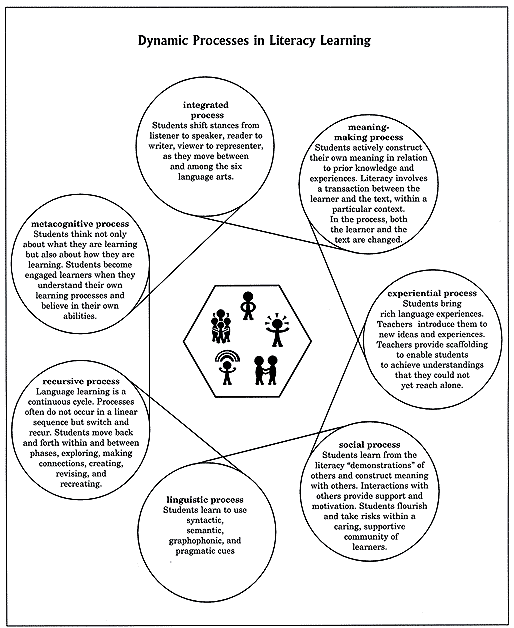Kindergarten to Grade 4 English Language Arts: A Foundation for Implementation
Implementation Overview: K-4
Literacy Learning Through the Six Language Arts - Part 2
Dynamic Processes in Literacy Learning
Literacy learning involves many processes. The diagram entitled Dynamic Processes in Literacy Learning (see below) identifies some of the key processes that form the conceptual underpinnings for effective literacy learning in language arts classrooms.

Common Processes in the Six Language Arts
The six language arts share common learning and cognitive processes. Reading, viewing, and listening processes are concerned with constructing meaning from texts created by others. Writing, speaking, and representing processes are concerned with constructing meaning in order to communicate with others. In the construction of meaning, learners are involved with both the expressive and the aesthetic qualities of language, and also with its transactional purposes (the exchange of ideas and information).
The diagram entitled Common Processes for Making Meaning in the Language Arts illustrates the processes for effective literacy learning in a totally integrated language arts curriculum. The centre column of this diagram identifies the learning processes common to all six language arts. The left side of the diagram indicates how comprehension processes are used in constructing meaning from the texts of others; the right side indicates how composing processes are used in creating texts to learn and to communicate with others.
Literacy learning is always focussed on the integration of new information with the prior knowledge the student brings to the task. While the Before, During, and After framework can be superimposed onto this diagram, learning processes need to be seen in terms of a continuously recursive and renewing cycle of language learning and growth. Integration of information occurs within all literacy processes. Students become more proficient in the processes with effective teacher modelling, guided instruction, and practice. Over time, they learn to comprehend and compose increasingly more complex and sophisticated texts on their own.
Viewing and Representing
While the six language arts cannot be separated in a real sense in the classroom, viewing and representing are discussed separately here because they have been formally identified as language arts in this curriculum.
Many students are avid and sophisticated consumers of visual media, and their familiarity with visual forms may facilitate literacy with other forms. Through experience, students may have an implicit understanding of visual media conventions — the unspoken agreements between directors and audiences about the way meaning is represented (for example, how the passage of time is conveyed in a television program). Teachers can make use of this knowledge, creating links between conventions in visual media and similar conventions in written texts.
Viewing and representing are language arts in their own right. Students need to learn the techniques and conventions of visual language to become more conscious, critical, and appreciative readers of visual media, and more effective creators of visual products. Younger students need to be shown that what a camera captures is a construction of reality, not reality itself. Students need to learn how to decide what is real and what is make-believe. They need to learn that images convey ideas, values, and beliefs, just as words do, and they need to learn to read and interpret the language of images. Many contemporary authors, in fact, use the term reading to describe the process of decoding and interpreting visual texts.
Films and video productions enlarge students’ experiences much as written texts do, and they offer similar occasions for discussion. Films also provide rich opportunities to explore the parallels and differences between visual and written language. Students may examine the effects of visual language cues: composition, colour and light, shadow and contrast, camera angles and distance, pace and rhythm, and the association of images and sounds. They learn to identify point of view by following the eye of the camera. Whether interpreting a painting or a poem, the "reader" may look at or be taught to appreciate elements such as pattern, repetition, mood, symbols, and situation or historical context. Students may enhance their own products and presentations by using visuals with written text and/or sound.
Studying the strategies used by authors and illustrators beginning in the Early Years helps students become conscious of the effect of visual elements in texts. Illustrations interact with words to enrich comprehension and can influence students’ interpretations of setting or of characters. Illustrations may show things that words do not, or they may express a different point of view from what the narrative does. The medium used for illustration is a cue to meaning. Visual cues such as colour, tone, shape and texture, line and composition all contribute to the viewer’s construction of meaning.
Students may use visual representation for both informal and formal expression. Just as they talk and write to explore what they think and to generate new ideas and insights, Early Years students may paint, draw, or sketch. Drawing may, in fact, be the first and most natural way for some students to clarify thinking and generate ideas. They may also use tools such as frames, maps, webs, and other graphic organizers to comprehend parts and their relationships. Visual tools are especially useful because they can represent the non-linear nature of thought and show dynamic relationships among ideas.
Students also may use representation to express their mental constructs of the ideas, theories, or scenes in written texts. Events, ideas, and information may be depicted in graphic organizers, storyboards, murals, comic books, or collages. After studying visual media, students make informed use of design elements in developing charts, slides, posters, and booklets. Other creative forms of expression, such as music, drama, dance, or mathematics, can be means of representing students’ understanding of a topic or a concept. The inclusion of representing as a language art extends the means by which students can communicate and demonstrate their learning in authentic ways.
Back to Implementation Overview: K-4


